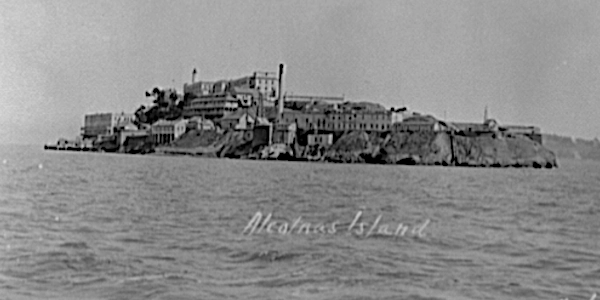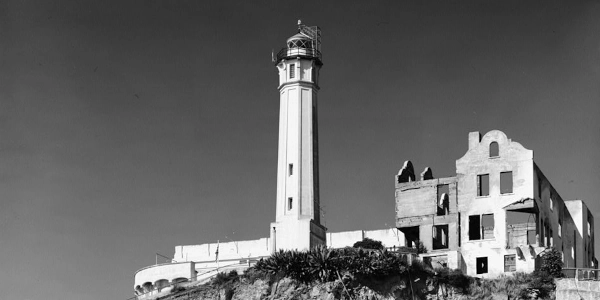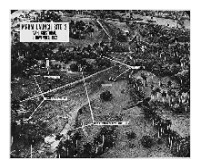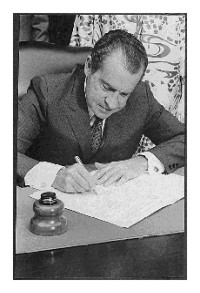Sponsor this page. Your banner or text ad can fill the space above.
Click here to Sponsor the page and how to reserve your ad.
-
Timeline
1963 - Detail
March 21, 1963 - The last twenty-seven prisoners of Alcatraz, the island prison in San Francisco Bay, are ordered removed by Attorney General Robert F. Kennedy, and the federal penitentiary is closed.

There had been plans to close Alcatraz for several years, and despite an escape attempted on December 16, 1962, with both caught, or that of three others on
June 11, 1962, of which all three were never seen again and presumed drowned (one man did wash ashore dead yet could not be identified), that was not the cause of the closure. Alcatraz was just too expensive to upkeep and run. It was in need of three to five million dollars in restoration by 1963, and its daily operating costs were $10.10 per capita versus $3.00 at other Federal prisons. A good part of that cost was in the transportation of water to the island weekly; nearly one million gallons were needed every seven days.
One newspaper from March 18, 1963, the Dayton Daily News, sums up some of the reasons and possibilies, somewhat contradicting the above, and although a current source, does not have the benefit of sixty years of look back history.
End of Alcatraz -- Haven for Tourists or Pelicans
Picture, if you can, sight-seeing boats running to and from Alcatraz island every hour on the hour.
Imagine tourists crawling all over "the rock" oohing and ahing at such information as "and here, ladies and gentlemen, is where Al Capone slept in isolation."
The glowering rock in San Francisco bay has a history, mostly grim, that dates back to 1854. For the past 29 years it has been the nation's toughest prison, the tantalizing lockup for gangland's most hardened criminals, but by July 1 it will be closed and abandoned.
WHAT TO DO with it is a topic of great speculation. If something isn't done soon, the 20 acre island could become a deserted crag, crowned by decaying buildings and an automatic lighthouse. The pelicans for which it was named could take over again.
Leaving Alcatraz for the birds, however, has no place in the imagination of Mayor George Christopher of San Francisco. He has asked California's congressional delegation to introduce a bill for a special study commission on Alcatraz' future.
It is his idea to send tourists by the boatland from Fisherman's wharf, just a mile and a quarter away.
"I believe hundreds of thousands of people would pay a dollar apiece to see the prison as it was, to rub elbows with the ghosts of Capone, Machine Gun Kelly, and all the others," the Mayor said.
Then, after interest died down, I would want to see something truly magnificent put there, a huge statue like New York's statue of liberty big enough so you could climb into the fingers."
The Justice Department decision to abandon Alcatraz prison followed two sensational breaks last year, although the connection is not acknowledged.
JAMES V. BENNETT, director of the Federal Bureau of Prisons, told congress that Alcatraz would have to be rebuilt or a new prison should replace it. An estimate that renovation would cost about $5 million brought the announcement that Alcatraz would be "phased out" in 1963.
A break by three daring bank robbers brought matters to a head.
Frank Morris and brothers John and Clarence Anglin made for shore the night of June 11-12, 1962, equipped with prison-made raft, paddles, and water-wings. It developed that they had chipped through decaying concrete with spoons, set up a workshop atop their cellblock, and roamed in and out at night, probably for months.
They are presumed officialy to have drowned, but their exploits underlined what Director Bennett himself called Alcatraz' rundown and eroded condition.
Then last December John Paul Scott and Darl Dee Parker, two more bank robbers, finished what Morris and the Anglins had started.
Scott used kitchen cleaner and a banjo string to saw through a bar. Parker happened to be there and went along. Parker was picked up on a rock 100 yards from the island, but Scott swam to the mainland.
Scott was near death when found, but he had proved that a convict could survive the swift tides and 50-degree water. Alcatraz' awesome reputation was irreparably damaged.
Now operation phaseout went into high gear. In June 1962, there were 269 prisoners on the island, now there are only 34.
Warden Olin G. Blackwell, who probably will be the last at Alcatraz, says the erosion wrought by the salt air and the bay's rough weather doomed the prison long ago. He implies that the escapes would not have been possible if money had been made available to maintain the physical structure.
With the abandonment of Alcatraz as a penitentiary, the latest chaper in a long, lurid history will draw to a close.
Ignored by the Spaniards and Mexicans, Alcatraz as a habitat for man started with erection of a lighthouse in 1854. It became a U.S. Army fort in 1858.
Confederate sympathizers who tried to sieze the fort in the Civil War became instead its first prisoners. In 1868 it officially became an Army prison, holding, amoung others, fierce Indian chiefs captured on the great plains.
In 1933, the Army quit the island, and in June, 1934, the first civilian convicts arrived.

Minute Walk in History
Alcatraz Fort and Prison
A foreboding island in the middle of San Francisco Bay that was founded by the Spanish, bought by the government, and originally turned into a fort to help defend the city and bay. But it quickly became a prison, at first for the military, but then for some of the most notorious criminals in USA history; Al Capone, Machine Gun Kelly, the Bird Man of Alcatraz, the Anglin brokers, and many more. Forty-six men tried to escape. Five are still missing, apparently drowned, the others caught or killed. Watch this amalgamation of still pictures and video that tell the story how the fort became a prison and now the prison a tourist attraction. Of course, Donald Trump just suggested he may turn it back into a prison.
More Alcatraz History
It was known as the Rock, however, when the Spanish discovered and mapped out the bay in 1775 during the explorations of Manuel de Ayala, it was known as Alcatraces, loosely translated into Pelican or Big Bird. It was part of the triangle of defense by the United States after the Gold Rush hit San Francisco and California. In 1850, the U.S. Army, under Presidential Order, built a Citadel atop the island, as well as Fort Point and Lime Point. Alcatraz would be the most fortified with one hundred cannons, although they never fired a shot. In 1854, the lighthouse there became the first on the Pacific Coast. It was part of Civil War defenses, and held prisoners from the Confederate privateer ship J.M. Chapman after it was captured.
The post began to take military prisoners in the late 1850's. It would stay a prison until 1963, until 1933 as a U.S. Army prison when it was transferred to the U.S. Federal Bureau of Prison. It would be a maximum security prison of the highest note, especially needed during the crime wave of the 1930's. The Citadel itself had been torn down by the Army in 1909, with its base used to build the new facility, which took two years, and was built by the prisoners themselves.
Yes, there were high profile gangsters housed there, plus prisoners who had attempted to escape other federal prisons or were deemed too dangerous to be held elsewhere. Those of high profile; Al Capone, George "Machine-Gun" Kelly, Alvin Karpis, Robert Stroud, and Arthur "Doc" Barker. The population of the prison was small, around two hundred and seventy-five and never reached its capacity of three hundred and thirty-six. While Alcatraz was certainly the prison for the worst of the worst, it was a state of the art prison per condition when built, and even had cells for only one person. However, those cells were small, five by nine feet in Blocks B and C; D Block cells were bigger, but they were for prisoners who were segregated due to their danger and had to remain inside twenty-four hours per day, except for one weekly visit, alone, to the yard. The cells had a cot, sink with cold running water, and a toilet. A Block was mostly used for storage, but did hold three prisoners after the 1946 riot while waiting for trial in the killing of two Alcatraz guards. This was not the only time someone was murdered at Alcatraz; eight prisoners met that fate at the hands of their mates.
There were fourteen escape attempts from Alcatraz, involving thirty-six men. Most were captured, killed, or drowned. Five are still missing and considered drowned. It was possible to swim from Alcatraz to the mainland, one and one quarter miles, but you had to be an expert swimmer to overcome the cold temperatures and swift currents. Although there were small sharks in San Francisco Bay, none were man-eating. A total of circa 1,545 men were imprisoned there during the Federal Prison System years; on average, their stay was eight years.
Alcatraz Actuality After Closing
The site was basically abandoned. Six years later, on November 20, 1969, it was the site of the Indian protest over Native American issues. They wanted to use the island as a cultural and education center. However, they degraded the complex over their year there, and were removed in June 1971. Other ideas were floated; creating another Statue of Liberty type statue, as the Mayor noted above, as an icon on the west coast. Making it into a hotel and shopping center were considered. In the end, after a decade of misuse, the National Park Service included the site as part of the Golden Gate National Recreation Area, which was established in 1972. Alcatraz was opened for visitors one year later.
There are tours of the site on a daily basis from the docks of the Recreation Area, provided by Alcatraz City Tours and the National Park Service. If you wish to go on a tour, you should book a week in advance due to the demand. They embark from Pier 33. Prices, as of 2025, are, for day tours (2.5 hours), $47.95 for Adults; $29.15 for Children 5-12. Other longer tours and special tours are available.
In May 2025, President Donald Trump stated that he would like to open Alcatraz again as a maximum security prison. Stay tuned.
Photo above: Alcatraz Prison, 1920/1950, Theodor Horydczak. Courtesy Theodor Horydczak Collection at Library of Congress. Photo below: Alcatraz, Warden's House, Alcatraz Island, San Francisco Bay, Date Unknown, Jet Lowe/Liz Jandoll, Historic American Buildings Survey. Courtesy Library of Congress. Info source: "Alcatraz Origins," Federal Bureau of Prisons; alcatrazhistory.com; "The Fascinating History of Alcatraz Island," National Park Service; "End of Alcatraz -- Haven for Tourists or Pelicans," 1963, Dayton Daily News; Wikipedia Commons.







